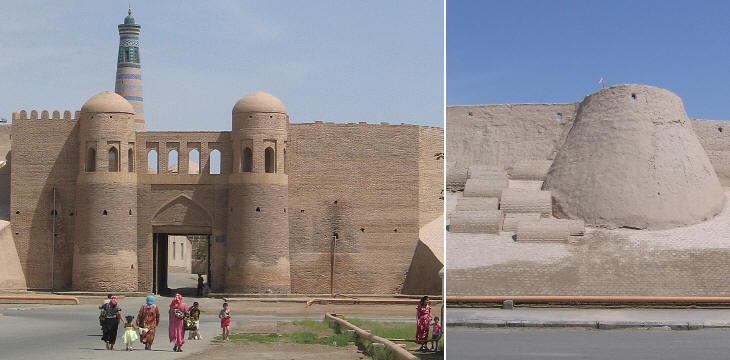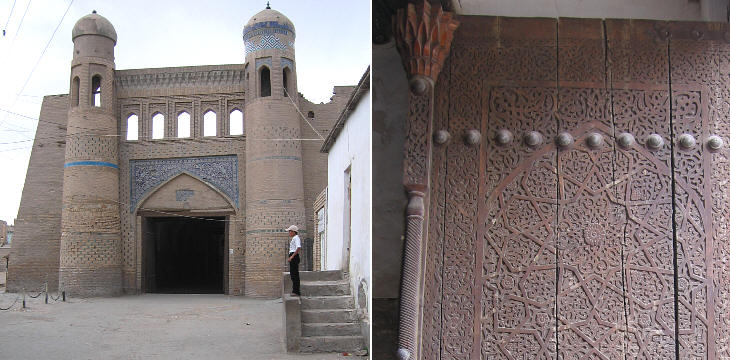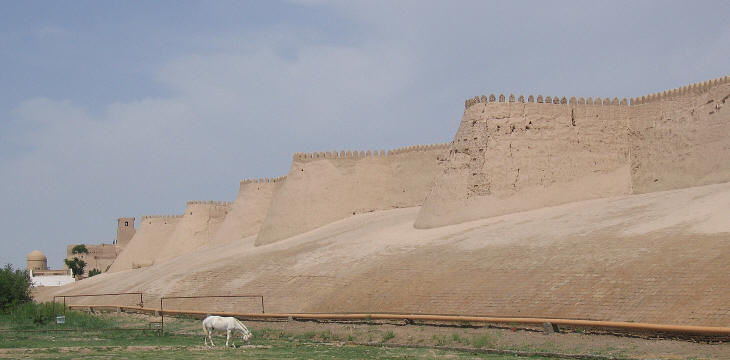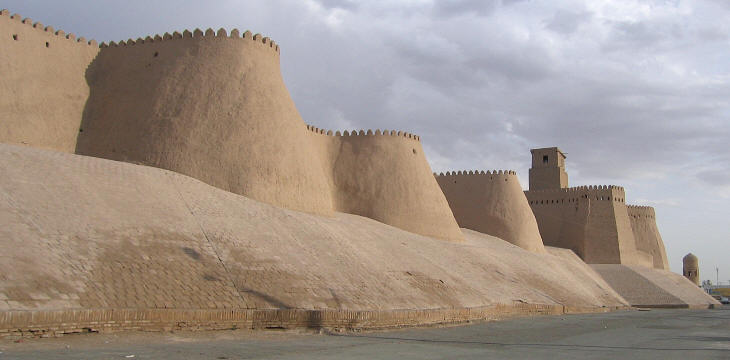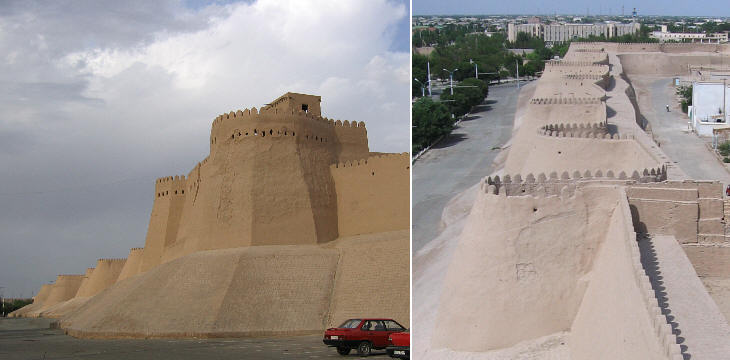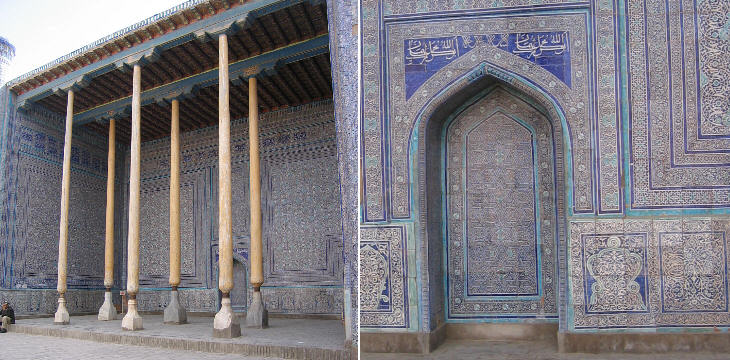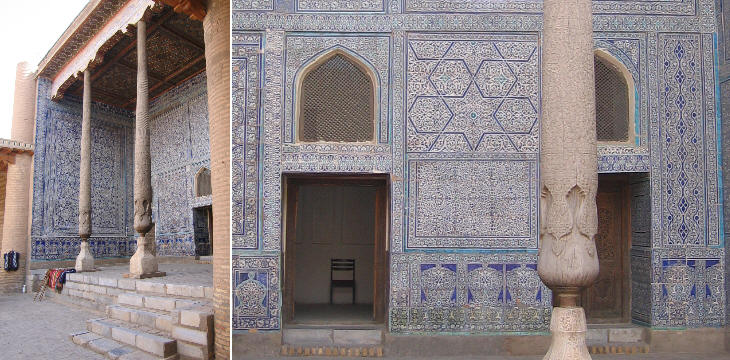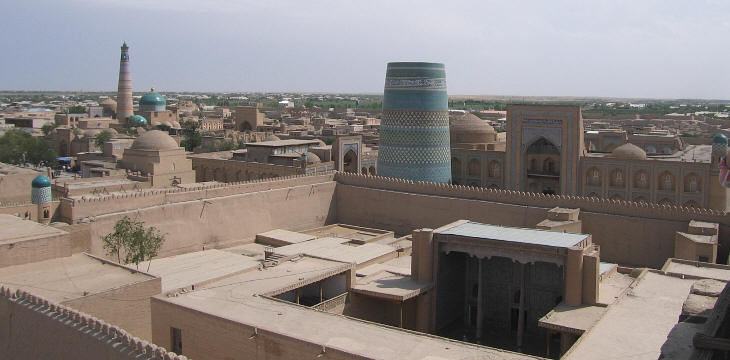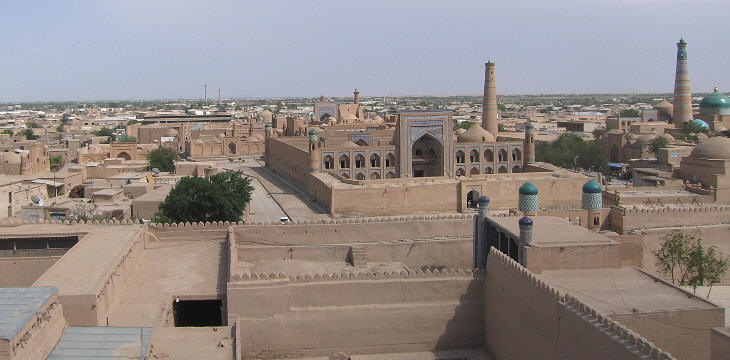  What's New! Detailed Sitemap All images © by Roberto Piperno, owner of the domain. Write to romapip@quipo.it. Text edited by Rosamie Moore. |
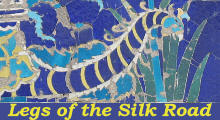 - Khiva - page one - History and Fortifications - Khiva - page one - History and Fortifications(detail of a decoration at Abdoul Aziz Khan Medrese in Bukhara) For centuries the name of Khiva struck terror into the Russian settlers whom the tsars had relocated to the east of the Volga River. They knew that Turkmen raiders who attacked their villages, abducted the peasants and brought them to the slave market of that far away town, which lay beyond the vast Kara Kum (black sands) desert.
Khiva is located near the Amu Daria River and the land around the town was very fertile. However the tribes who lived in the region regarded farming as a humble occupation and preferred to raid Persian or Russian villages to employ their inhabitants as cheap labour in the fields. The harsh climate of the region and poor hygiene and living conditions greatly reduced the life expectancy of the abducted peasants; for this reason Khiva had a very flourishing slave market.
The rise of Khiva dates back to the XVIth century; before that period the most important town of Khorezm (the name of region) was (Old) Urgench. This town knew a great development in the XIIth century but, after having been razed to the ground in 1221 by Genghis Khan and by Timur in 1370, it was eventually abandoned. The Amu Daria River changed its course and this was another factor which led to the town's abandonment. Today Old Urgench is located in Turkmenistan, while a town by the same name was founded in the XVIIIth century twenty miles to the east of Khiva.
In the XVIIth century Khiva became the capital of a Khanate independent from that of Bukhara and the imposing walls which surround Itchan Kala (Inner Town) were built in 1686-88. In the following century Khiva had to face the revolts of several tribes and the Persian threat. In 1740 the Persians occupied Khiva and destroyed many of its monuments, which were rebuilt in the following years. In 1770 the power was seized by the Qungrat inaqs (royal advisors) who eventually deposed the Khan in 1804 and ruled Khiva until 1920.
In 1717 Tsar Peter the Great sent an expedition to Central Asia to explore the region and identify a possible route to India. Prince Alexander Bekovitch-Cherkassy led the expedition; he was of Circassian origin (a region in Caucasia) and therefore familiar with Muslim traditions and Turkic languages. When he reached Khiva with 4,000 troops he was welcomed by the Khan who suggested his army be lodged in five different locations around Khiva for better foraging. In the following days the Russians were attacked and many of them were slaughtered while others were sold as slaves. According to a survivor's account Prince Bekovitch was flayed alive. For more than one century no other Russian armies were sent against Khiva.
In 1839 General Vasily Alekseevich Perovsky moved from Orenburg, a Russian military outpost, to attack the Khanate of Khiva and stop its slave market of Russian peasants. He chose the wrong period (November) to cross the frosty desert and was forced back by winter storms without having been able to reach Khiva. It was evident that in order to exploit their military edge over the Khanate warriors, the Russians needed more information. In 1858 Nikolai Pavlovitch Ignatiev, a young Russian officer managed to reach Khiva and (of even greater importance) to safely return with first hand strategic information.
In 1873 Russian troops moved towards Khiva from four different directions and the Khan had no other options than to accept the Russian protectorate. Similar to the Emirate of Bukhara, the Khanate of Khiva survived until 1920 when the Soviet army conquered the town. In 1924 Turkmen rebels made a failed attempt to seize Khiva. In that same year the Khanate became part of the Soviet Republic of Uzbekistan.
The high walls which surround the old town had also the objective of protecting it from desert storms. Their wave-like design is fascinating and per sŤ it justifies the inclusion of Khiva in the UNESCO World Heritage List.
The Khans had several residences in Khiva, but that on Kouchna Ark (old citadel) next to the western gate was the safest one. It included a high bastion (Akcickh-Bobo) from which they controlled what was going on in the whole town.
The continental climate of Khiva required different facilities for coping with extreme cold and hot weather. In summer in Kouchna Ark both receptions and prayers took place in porticoes facing north; their height granted some circulation of air while their positioning kept them in the shade. The throne hall and the mosque in the Khan's Kouchna Ark palace were built in the first half of the XIXth century. Go to Khiva - page two Introductory page Samarkand Bukhara Chakhrisabz  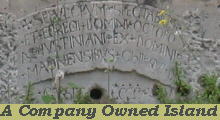  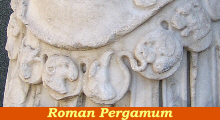 |
